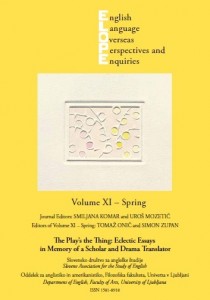This week a few presentation tips. Adapt them according to the class and subject matter:
– Your first sentence does not have to be “This presentation is about…” Think of movies that start with action scenes before the opening credits roll. Why not lay out your topic two minutes into the presentation? (Also, if you have the topic emblazoned across your Powerpoint, you can be subtle: “As you can see…”)
– The typical tripartite structure is not always necessary. “First I will…, then I will, then I will…” Sometimes a narrative, meandering structure is more fun and useful. Especially with less academic topics – say, chocolate or my puppy Leonard – there can be a gap between form and content (“First, I will elucidate how we acquired Leonard from the pound; then I will examine the factors involved in re-naming Fluffy Leonard; in the third section, I will explain how Leonard prefers…”)
– Limit yourself. If have ten minutes to work with, skip the nine-minute-biography, stick to three rather than nine points. You can cover your bases by saying, “Of course, we don’t have time for…” or “It’s too bad we can’t discuss the late Wittgenstein at this point…” (i.e. show that you know more than you are relating)
– Consider the audience and the time of day. Early morning? Your classmates might be asleep and might need to be coaxed into Deep Thinking. Late afternoon? The later in the day, the harder you’ll have to work to get or keep our attention. Is this a Practical English class? Give us a chance to participate!
– Engage the audience at least every two minutes. Have students read from the overhead; ask a rhetorical question; ask if we agree with something – none of these takes any time away from your presentation.
– Don’t use more than three borrowed words in a row. Even if you are not plagiarizing, the audience can hear a different “voice.” (Of course, look up the meaning and pronunciation of words that are new to you.) If you are paraphrasing another thinker, tell us!
– Be fair with questions: it’s useful to lead into a tricky question with a series of little ones. Few people will spring to answer an out-of-the-blue questions such as “Can anyone briefly explain the essential differences between verb movement in Slovenian and English?” (A pre-question here could be: “Which language lets you move things around more? Slovenian or English?”)
– Don’t be a control freak. Discussion can be scary because someone might ask a very tricky question or seem to outshine you during your moment of presentation-glory. Worse, however, is ignoring the audience altogether.
– Make sure that what you say can’t be delivered in paper form – i.e. that your presentation is not merely an essay read loud; even if it’s a mere matter of humour or enthusiasm.
– Powerpoints (sp?). Nothing to tell you. Students all seem to have grasped that the overheads should be digestible, fun, not overly long and not too distracting.
– Videos. If you play a clip: keep it short; ending with a clip is dangerous (you want the final statement to be you; no need to compete with Spielberg).
– You don’t always have to end with a bibliography or works cited (in my view, even if you do mention your sources, one or two minutes is more than enough).
– If you say, “In conclusion…” finish up within a minute.
More here: http://www2.arnes.si/~bjason/index.html#guides


